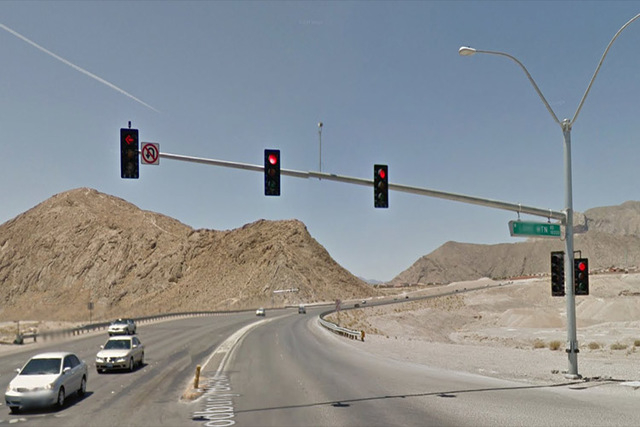Slow progress for Beltway upgrades

Motorists who regularly drive the 215 Beltway are familiar with the huge differences between the freeway along the southern and western portions of the highway and what exists in the north.
In the south and the west, the county road is interstate-highway quality, complete with six or more traffic lanes, lengthy exit and entrance ramps and beautifully designed and landscaped overpasses at major intersections.
To the north? Not so much.
On the Beltway north of the Cheyenne Avenue exit, the road curves around Lone Mountain and drops from interstate-highway to four-lane road with traffic lights on the Beltway at Lone Mountain Road and Ann Road.
As the highway curves to the east, it’s a mix of freeway and four-lane road through the exits at Hualapai Way, Durango Drive, Jones Boulevard, Decatur Boulevard and Fifth Street. From Fifth east to Interstate 15, it’s just four lanes, complete with traffic lights at Losee and Pecos roads, Lamb Boulevard and Range Road. Someday, overpasses will be built at those intersections and what serves as the highway today will become the exit and entrance ramps.
Snarls at the traffic lights at the Beltway and Ann and Lone Mountain roads recently inspired some readers to inquire about finishing the Beltway.
The bottom-line answer: you’re in for a long wait.
But maybe that’s the way it should be. After all, the stretch of highway from Fifth to I-15 is pretty barren except for the beautiful Veterans Administration Hospital in North Las Vegas that looks oddly out of place in the middle of nowhere off Pecos Road and the Beltway.
Aside from that, there are virtually no commercial entities and a few single-family residences and apartments off the Beltway.
Tony Illia, a Nevada Transportation Department spokesman, said there are no current plans to upgrade the Beltway to freeway standard between Cheyenne and Hualapai or to eliminate the traffic lights.
As for the rest of the northern piece of the Beltway, Illia said progress will be slow.
“There is a feasibility study being done for an I-15-Beltway north interchange,” he said. “NDOT recently issued a request for proposals, but things remain in the early preliminary stages. There has also been ongoing discussion and contemplation about another ring road encircling the Las Vegas Valley. Potentially, it would reach the edge of the Shadow Mountains on the north side and tie into U.S. Highway 95 and I-15. However, the project’s future relies on a combination of political will, development activity and funding availability.”
There are two other important pieces of the Beltway, one in the works, one on the back burner. Those are the interchanges with major highways, U.S. 95 in the northwest valley and the northern I-15 connection just south of Las Vegas Motor Speedway.
On the U.S. 95 interchange, funding has been identified to begin work on ramps for two key traffic movements, northbound U.S. 95 onto the eastbound Beltway and the westbound Beltway onto southbound U.S. 95.
Construction is expected to begin in the spring and take 20 to 24 months to complete.
The interchange will feature a two-lane, 2,400-foot flyover bridge that will soar 70 feet above the ground at its highest point and move traffic from the westbound Beltway to the southbound U.S. 95.
The I-15 interchange would occur well into the future.
Some community leaders have told me that they’d like the Transportation Department to explore the possibility of moving the Beltway tie-in to I-15 a little farther north — like north of the Speedway.
That would likely be an expensive undertaking, but those who have been trapped in event traffic from the Speedway point out that having an alternative access to the north would be beneficial in those rare occurrences when the city hosts events like NASCAR races or the Electric Daisy Carnival and traffic gets really heavy.
HOLIDAY LEFTOVERS
Speaking of heavy traffic, I-15 south to Southern California was a predictable disaster the Sunday after Thanksgiving as people who celebrated the holiday here made their way home to SoCal.
“Thanksgiving Sunday,” as Brian Hoeft, the director of the Regional Transportation Commission’s Freeway and Arterial System of Transportation, calls it, is the worst of four holiday-weekend travel periods on I-15.
The cause of the mess is the three lanes of I-15 narrowing to two at Primm.
Normally, it takes 30 minutes to get from the 215 Beltway to the state line. That Sunday, it took an additional 70 minutes with the worst of it occurring between 10 a.m. and 3:15 p.m.
Hoeft said the other ugly days are the Sundays of the Memorial Day, Fourth of July and Labor Day weekends. Other three-day weekends are slightly easier to deal with.
When traffic on I-15 was at its worst, the dynamic signs north of the Spaghetti Bowl were recommending travel to Southern California by way of U.S. Highway 95 to Searchlight, then west on State Route 164, which becomes Nipton Road at the California border, a distance of about 103 miles compared with 54 miles via I-15.
Overall, delays occurred between 7 a.m. and 8:30 p.m. and the line was about 27 miles long.
Questions and comments should be sent to roadwarrior@reviewjournal.com. Please include your phone number. Follow the Road Warrior on Twitter @RJroadwarrior.